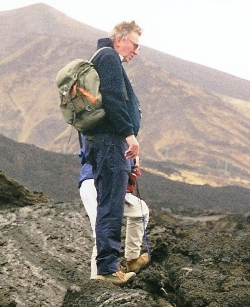Volcanologist and planetary scientist who inspired generations of students at UCL  over half a century
over half a century
John Edward Guest was a pioneer in volcanology and planetary science. Born in London on 6 December 1938, he had an enthusiasm for the natural world - from geology to ornithology - that he used to inspire generations of colleagues and students. He died on 19 May 2012 at his Shropshire home in Church Stretton and leaves a widow, Mary, and two sons, Ben and James.
Picture: John Guest on Mt Etna, Sicily. Photo: Angus Duncan.
John saw his academic work not as a job, nor as a career, but as a vocation. Graduating from University College London (UCL) in 1962, he remained with the university for almost 50 years. In that time, he established the emerging disciplines of planetary geology and physical volcanology at UCL and, in 1980, he founded the first NASA Regional Planetary Image Facility outside the USA.
During his PhD with Sydney Hollingworth on Tertiary ignimbrites in the Chilean Andes, John honed his flair for field geology and ruminated on how his Chilean colleagues endured sub-zero temperatures in ponchos and jeans. The PhD also confirmed a fascination for volcanoes that led him into research around the world, including Jan Mayen island, Iceland, Bioko island, Hawaii, the Azores and southern Italy – most notably Sicily’s Mt Etna. He was among the generation of scientists who recognised the importance of transforming volcanology into a physical discipline and, even though he described himself as a field geologist, he vigorously promoted advances in quantifying the effusive behaviour of volcanoes. In 1973, he led the UK contribution to a 10-year Anglo-Italian project to investigate the evolution of Mount Etna. The collaboration produced the modern geological map of the volcano - the first for more than a century – and launched a new understanding of Etna’s magmatic feeding system and eruptive dynamics.
Through his drive for extending traditional studies into new arenas, John pursued a postdoctoral project on the origin of lunar craters. Despite his passion for volcanoes, he argued against the prevailing wisdom that the craters were volcanic and supported the view that they were the result of meteorite impacts. He became one of the first non-US citizens on NASA’s programme for planetary exploration and joined the science teams for missions to Mercury (Mariner 10, launched in 1973), Mars (Viking, 1975) and Venus (Magellan, 1989). He also engaged with the Soviet Phobos mission to Mars (1988). For his contributions to planetary geology, he received the 1991 G K Gilbert Award from the Geological Society of America; in the same year, asteroid 1982 HL was named Guest by the International Astronomical Union.
An extremely quick thinker on his feet, John had a formidable talent for grasping the logical core of an argument. He had also the ability to prevail in a debate without causing offence. This made him a considerable influence behind the scenes during project design and management and, at the same time, popular with colleagues whatever their views during discussion. He was a born raconteur and deeply curious about the countries and cultures where he worked. Combining these traits, he built-up a legendary fund of tales, some taller than others, from his long experience in different parts of the globe.
He would happily recount how in 1984 the UK Government asked him to assess the threat of volcanic unrest to British personnel at a NATO base in the heart of Campi Flegrei, an active caldera just west of Naples. He presented what he felt was an uncontroversial report. The following day it had been leaked to a national Italian newspaper that ran the banner headline “Bye Bye Naples”. All John’s debating skills were required to alleviate the concerns of the Italian cabinet. At the other extreme, he would advise students accompanying him to work on Hawaiian lavas that a key field threat was a poisonous snake that could lie camouflaged among the coils of ropy surfaces on pahoehoe flows. Only after the students had spent a day or two of trepidation while negotiating the lavas would he point out that Hawaii was well-known for its absence of snakes. For this spirit alone, John was an ideal companion in the field (at least after snake hunting), an arresting and inspiring lecturer and, to his co-workers, a friend, colleague and mentor.
By Christopher Kilburn, David Chester, Angus Duncan, Rosaly Lopes, Derek McNally, John Murray, Ellen Stofan and Denis Timm.